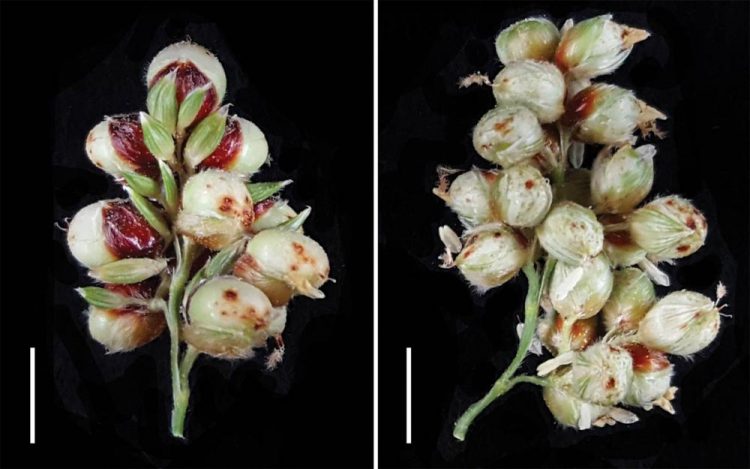Researchers double sorghum grain yield to improve food supply

The left image shows the grains of a normal sorghum plant. The right image depicts how the amount of grains doubled in the genetic variant. Credit: Ware lab/CSHL, 2019
Sorghum, one of the world's most important sources of food, animal feed, and biofuel, is considered a model crop for research because it has a high tolerance to drought, heat, and high-salt conditions.
Increasing the grain yield has become even more important to plant breeders, farmers, and researchers as they try to address and overcome food security issues related to climate change, growing populations, and land and water shortages.
Led by Doreen Ware, CSHL Adjunct Professor and research scientist at the U.S. Department of Agriculture, and USDA colleague Zhanguo Xin, Ph.D, the research team identified novel genetic variations that occurred in sorghum's MSD2 gene, increasing the grain yield 200 percent.
MSD2 is part of a gene line that boosts flower fertility by lowering the amount of jasmonic acid, a hormone that controls the development of seeds and flowers.
“When this hormone is decreased, you have a release of development that does not normally occur,” said Nicholas Gladman, a postdoctoral fellow in Ware's lab and first author on the study, recently published in The International Journal of Molecular Sciences. “That allows for the full formation of the female sex organs in these flowers, which then allows for increased fertility”
MSD2 is regulated by MSD1, a gene discovered by Ware's team last year. Manipulating either gene increases seed and flower production.
“Major cereal crops are very close to each other evolutionarily. A lot of the genes that they share have similar functions,” said Yinping Jiao, a postdoctoral associate in the Ware Lab and an author on the study. “This gene that plays an important role controlling the sorghum yield may also help us improve the yield of other crops like maize or rice.”
Ware's lab uses this type of genetic research to understand how plants have changed over time.
“These genetic analyses actually give us the molecular mechanisms that provide more opportunities to engineer crops in the future,” she said.
###
The team is now looking to work with collaborators, such as the United States Department of Agriculture, to see if one of the genes–MSD2 or MSD1–can be used to improve sorghum yield in large field trials.
Media Contact
All latest news from the category: Agricultural and Forestry Science
Newest articles

An Endless Loop: How Some Bacteria Evolve Along With the Seasons
The longest natural metagenome time series ever collected, with microbes, reveals a startling evolutionary pattern on repeat. A Microbial “Groundhog Year” in Lake Mendota Like Bill Murray in the movie…

Witness Groundbreaking Research on Achilles Tendon Recovery
Achilles tendon injuries are common but challenging to monitor during recovery due to the limitations of current imaging techniques. Researchers, led by Associate Professor Zeng Nan from the International Graduate…

Why Prevention Is Better Than Cure—A Novel Approach to Infectious Disease Outbreaks
Researchers have come up with a new way to identify more infectious variants of viruses or bacteria that start spreading in humans – including those causing flu, COVID, whooping cough…



